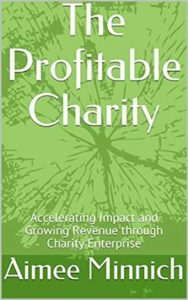The Profitable Charity: Encouraging Nonprofits to Create Some of Their Own Funding
Travis Hurley
Director of Advancement
Read more from Travis
Jump to:
The Purpose of the Book | The Perspective | The Key Points | Details We Love | Considerations | Who Should Read This?
Have you wrestled with a growing sense that charity alone isn’t enough to solve the world’s deepest problems? Whether it’s feeding the hungry, ending human trafficking, providing clean water or translating Scripture, nonprofit leaders have been looking for ways to increase impact without creating fatigue for their financial donors. Aimee Minnich’s book, The Profitable Charity, is a primer on “Charity Enterprise,” a model for ministry funding that encourages nonprofits to embrace avenues of revenue building to fund their ministry. This allows for a decreased reliance on donor dollars alone while creating the potential for greater impact. Minnich so believes in the impact of this model, she left her role as President and General Counsel for the National Christian Foundation, Heartland, a $1 billion foundation, to co-found the Impact Foundation, which facilitates investments in charity enterprises and other impact companies.
Businesses built alongside charity have the power to change social dynamics in ways that charity alone simply cannot.” (3) While more than half of nonprofits incorporate some effort at income generation, few realize the full benefit of their efforts because they lack the necessary tools, knowledge, expertise and/or desire to develop those efforts. Meanwhile, organizations continue to struggle to meet fundraising goals for their current programs and are constantly dealing with donor fatigue and attrition, while always seeing other needs that could be met “if only.” Minnich advocates for Charity Enterprise, a “profit-making endeavor that funds and complements a charitable purpose. It’s not just a business that uses only its profits to fund ministry work. The business itself advances the mission.” (5) Minnich says that by blurring lines between ministry and business, this approach creates greater social impact while also making a profit that can be sown back into the ministry.
Minnich starts by looking at the challenges of traditional fundraising, characteristics of millennial giving, and the rise of socially minded businesses. In doing so, she establishes the problem that she believes charity enterprise can help solve, namely that changing donor demographics is making traditional fundraising increasingly difficult. Before showing how charity enterprise can be the solution going forward, though, Minnich acknowledges that it’s a concept easily misunderstood and spends a good section explaining what it is and what it is not, as well as addressing the obstacles that arise for those who attempt the charity enterprise model.
The remainder of the book is devoted to practical ideas for how to create sustainable revenue in a charity or nonprofit context, along with stories of those who are increasing their social impact by using a charity enterprise model. The thrift store established by Mission Adelante in Kansas City, KS, for example, provides revenue for the ministry to Latino and Bhutanese communities while providing employment opportunities to the immigrant population (37ff). Another example of charity enterprise arose from Brother in Blue Reentry (BIB), a prison outreach in Kansas, that eventually took over a prison’s cafe at the request of a warden. The cafe serves visitors to the prison, provides revenue to BIB, and employs inmates who gain experience in customer service and restaurant management (32-33).
While Minnich starts by looking at the state of traditional fundraising and the diminishing returns on desired social impact outcomes, she wisely pauses to make a brief theological case for charity enterprise (12-14). This helps overcome any potential characterization of her solution to the fundraising problem as being merely pragmatic. Perhaps the book’s greatest strength, though, is the time Minnich takes to clearly define what charity enterprise is and is not. She includes a helpful graphic that shows a spectrum of various models, from “profit only” structures that distribute earnings to owners (traditional businesses, tithing businesses, and impact companies) to “mission only” structures (charity enterprises and traditional charity), which reinvest earnings into the enterprise (20). From here, Minnich addresses the obstacles that prevent nonprofit leaders from fully engaging the charity enterprise model, exposing the “false dichotomy between mission and profit” (25) and offering a good example of a plan that can be put in place to provide accountability, prevent greed, and keep the focus on measurable spiritual and social outcomes from the enterprise.
We always appreciate when a book encourages the measuring of outcomes and, in charitable work among the poor in particular, a model like charity enterprise provides great opportunities for challenge-driven ministry—giving viable work opportunities for those willing and able to earn their basic needs. Charity enterprises are a great impact model of ministry that can help break the cycle of dependency for those in need while also offsetting the costs of the ministry itself, thus reducing the reliance on donor dollars alone.
This book is brief—that makes it a quick read but, for those persuaded by it toward the model of charity enterprise, Minnich’s book will only serve as a primer. Thankfully, there are helpful appendices regarding the practical and tax considerations for setting up a charity enterprise, as well as a list of additional resources for those who’ve dipped their toes into Minnich’s book and are ready to dive deeper into the charity enterprise model (61). These resources include The Lean Startup by Eric Ries for those looking to get started, The Four Disciplines of Execution by Franklin Covey for those looking for disciplined growth in their charity enterprise, and, for counsel along the way, the Impact Investing Charitable Foundation founded by Minnich herself.
We recommend this book for nonprofit leaders who resonate with the struggle Minnich describes, the limits of traditional fundraising, or for those who simply have a ministry vision currently constricted by the traditional fundraising model. We also believe those convinced of the “pillars of true charity” (voluntarily sourced, challenge-oriented, and outcome-driven) will find charity enterprise to be a great way to put all three into practice.
This article is just the tip of the iceberg for the practical resources available through the True Charity Network. Check out all of the ways the network can help you learn, connect, and influence here.
Already a member? Access your resources in the member portal.







